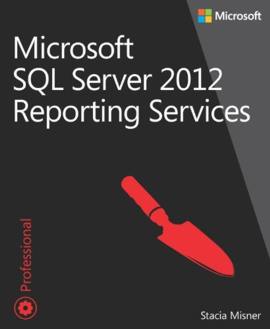| Microsoft SQL Server 2012 Reporting Services |
|
Author: Stacia Misner Is this book going to get you started with SQL Server Reporting Services? Stacia Misner is well known as an expert on Reporting Services, and has been writing about it since the days of SQL Server 2000. In this book she takes a fairly leisurely look at Reporting Services in SQL Server 2012. The book starts with a heads-up on what’s new in Reporting Services, as Microsoft made quite a lot of changes in SQL Server 2012, notably with the introduction of Power View, the ad-hoc reporting tool that’s largely aimed at the end user. Reporting Services is also re-invented as a SharePoint service application, which alters the way you can use it. For readers not familiar with Reporting Services, there are four chapters on getting started – introducing the environment, understanding how to deploy Report Services, installing it and exploring the fundamentals.
Part II of the book is where the more useful material starts – developing reports. The main difference between desktop databases and SQL Server (so far as reports go) is that the reports are stored and accessed on a report server, so essentially you create a report definition that is then used as the basis of a report running on the report server. Misner explains how this works, then looks at retrieving data for a report and designing the layout. Reporting Services uses the annoyingly named tablix as the generic data region. A tablix can be either a table, matrix or list, and there’s a chapter about working with the tablix. Expressions and functions each get a chapter, with short sample report definition code examples showing how to use them. There’s a useful chapter on adding interactivity such as letting your users choose different sort orders, or collapsing and expanding different report sections, and another good chapter on creating dynamic reports with parameters. The use of Analysis Services as a data source finishes this part of the book.
The next part of the book is essentially about charts and maps. Having shown how to add a chart to a report, Misner looks at ways to work with chart elements such as axis and series properties. She then goes on with chapters on adding gauges and performance indicators before turning her attention to maps. Reporting Services lets you combine reporting data with spatial data in a map, and Misner shows how to use spatial queries, Bing Maps layers, then how to add an analytical data set, and how to work with individual map elements. Administering the Report Server is the topic of the next three chapters, followed by a section on viewing reports – essentially how to use reports. Having shown how to create and use ad hoc reports using Power View, the final section is the one of most interest to developers – using Reporting Services as a development platform. There are chapters on the basics of Report Definition Language (RDL), and on programming report design components, report server management and report access. RDL is essentially XML, and you can take a report you’ve designed using Report Designer or Builder, and edit the XML that was created. There’s a short chapter on embedding code in a report for custom functions, but the longer chapters in this ‘developer’ section cover setting up scripts to manage the report server, and programming report access. This final chapter shows how to set up web pages that have links to reports managed on your report server. I felt a bit frustrated by this book. The pace at the beginning is slow and gentle, when the material for much of the book isn’t that hard; OK, so you’re working on a server, but it’s still just creating a report. Then, when we hit the more advanced topics, the coverage seemed to get much swifter when more examples and background would be useful. However, if you don’t know much (or anything) about Reporting Services and you need to learn it, the book would get you there.
|
|||
| Last Updated ( Monday, 25 November 2013 ) |

